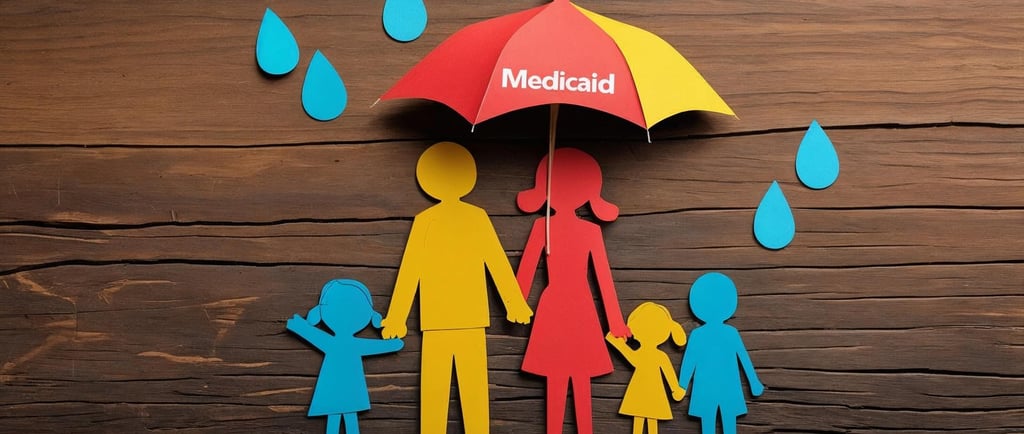The Medicaid Cliff: What Happens When Disasters Hit the Newly Uninsured?
As the U.S. navigates the largest rollback in public health coverage in recent history, emergency managers face an overlooked vulnerability: over 23 million people have lost Medicaid since the end of COVID-era protections- often without realizing it until crisis strikes. In high-risk states with elevated climate threats, that vulnerability is already translating into more complex response and recovery operations.
6/12/20252 min read


Why It Matters for Emergency Managers
Disaster response planning typically assumes that most people have some form of health coverage. This foundation enables timely access to medications, urgent care, and long-term recovery services. But the Medicaid cliff is eroding that assumption, especially in states facing:
More frequent and severe disasters driven by climate change
Limited investment in emergency healthcare infrastructure
Overburdened safety-net clinics and NGOs
Texas, Florida, Georgia, and Arkansas—all highly disaster-prone—top the list of states with the largest disenrollments (KFF).
Where Coverage Loss Hits Hardest
The loss of Medicaid coverage undermines multiple aspects of disaster readiness and response:
Mass Care & Shelter Operations: Triage needs rise, with more individuals requiring basic medical care and mental health support.
Emergency Medical Services: Delayed care and unmanaged conditions increase the complexity of patient transport and treatment.
Healthcare System Surge: Hospitals face spikes in uncompensated care and challenges in discharging patients without follow-up resources.
Pharmacy & Medication Access: Chronic illness management breaks down when prescriptions are interrupted.
Long-Term Recovery: Gaps emerge in rehab, behavioral health, and post-disaster care.
These are not theoretical problems. After the June 2024 floods in Arkansas, clinics reported a sharp increase in uninsured patient visits. Many hospitalizations were linked to missed medications and deferred care—direct consequences of recent Medicaid disenrollment (Arkansas Advocate).
Similarly, after Hurricane Idalia in 2023, community health centers in Florida’s Taylor and Dixie counties experienced a surge in patients with unmanaged asthma and diabetes. Most had lost Medicaid coverage earlier that summer and only discovered it when attempting to refill essential prescriptions (Healthcare Ready).
Cascading Policy Consequences
The Medicaid disenrollment crisis is unfolding alongside other major shifts in disaster and public health policy:
Stricter FEMA thresholds and reduced cost-share: If new federal disaster thresholds had applied from 2008 to 2024, Tennessee alone would have lost 37% of its disaster assistance (AP News).
Cuts to the Hospital Preparedness Program (HPP): The FY2026 budget proposal eliminates the HPP Cooperative Agreement, ending federal support for healthcare system readiness (Health Response Alliance).
Reduced Public Health Emergency Preparedness (PHEP) funding: PHEP appropriations fell from $918 million in FY 2003 to $735 million in FY 2023—a nearly 50% drop when adjusted for inflation (Trust for America’s Health).
More responsibility shifted to states: FEMA’s leadership has confirmed plans to increase state-level responsibility for disaster recovery beginning with the 2025 hurricane season (AP News).
Together, these trends mean larger and more complex responses with fewer resources and wider health gaps.
What Leaders Can Do
Emergency managers, public health officials, and policymakers can take proactive steps to reduce risk and improve disaster preparedness:
1. Integrate Coverage Loss into Risk Profiles
Map disenrollment data by ZIP code alongside local hazard vulnerability.
Create data-sharing partnerships with Medicaid agencies to monitor trends.
2. Plan Ahead for Healthcare Gaps
Engage Federally Qualified Health Centers (FQHCs) and free clinics in emergency planning.
Build standing partnerships with NGOs equipped to deploy mobile clinics and deliver medications.
3. Make Recovery Programs More Inclusive
Support the creation of disaster-specific Medicaid waivers and streamlined re-enrollment pathways.
Provide health navigators at shelters and Disaster Recovery Centers (DRCs).
4. Quantify and Communicate the Impact
Track uncompensated care after disasters and link it directly to coverage loss.
Share data with legislators and funders to make the case for investment.
A Health System Under Pressure
Emergency systems are increasingly absorbing the ripple effects of broader health policy decisions. Medicaid unwinding wasn’t designed with disasters in mind—but its consequences are now baked into crisis response.
Preparing for the 2025 hurricane season and beyond requires more than just better weather forecasting. It demands readiness for the structural health vulnerabilities that shape whether people recover—or fall through the cracks.
Health Response Alliance is a nonpartisan 501c3 tax-exempt organization.
All contributions are tax deductible to the extent provided by law.
Federal Identification Number (EIN): 33-2575005
© 2025 Health Response Alliance Inc. ALL RIGHTS RESERVED.
